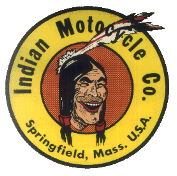Hello Tim , I am back on straight 50 in all my old American bikes (for now?) I did give parrafin (kerosene) a try but it's such a palarva mucking about adding to tank in garage and then trying to remember to take it with me when out riding , I gave up in the end . I copied an article on oil from the Henderson KJ site , hope the auther doesn't mind it being on here as I think quite interesting and a little tempting but I haven't taken the plunge yet !? maybe , not sure .
What's your opinion ??---- Ken
However, my experience (again with twins only) has shown that burning oil is often the culprit. In addition, burning oil causes carbon buildup in the cylinder, hence the need to remove the cylinders (or heads) and de-carbon, every season, as the owners manual suggests! What a pain!!! I have had endless debates with George Yarocki and many others about using, or not using oil control rings in total loss motors. Granted, the Henderson is not a total loss system, but other than that, it's basically the same, a hot running air cooled engine. Georges argument was that "these engines are designed to burn oil because that's the only way the top end gets lubricated". I disagree, if burning oil was such a good thing, then why do engine designers today go to such great lengths to keep oil out of the combustion chamber?!!! Because burning oil leaves carbon deposits on the pistons, heads, valves and rings and eventually can break off and cause severe damage as well as stick valves open due to carbon build up on the stem. That's why I'm a firm believer in installing oil control rings on these old bikes. THEN, I've always added a bit of 2 stroke oil to the gas as bit of a lube for the intake valve at least. I was told by a chemist that Marvel Mystery oil when added to the gas will drastically decrease octane and cause a very hot burn. I've seen this damage first hand, so I would not recommend Marvel oil in the gas.
OK, so what oil to use? My good friend Hans Coertse from So Africa is an amazing engineer, restorer and vintage rider. He has successfully competed in 3 Cannonball rides and 15 plus So. African DJ runs and more, all on pre 1930 machines. I saw a JD Harley that he pulled down after 10,000 miles. There was absolutely no carbon on the pistons, AT ALL ! No nicotine stains under the rings, no sign that the engine had been run for more than just a few minutes! He said there was a light dust on top of the piston which he simply blew off. I was amazed and inquired about what oil he was running. His answer shocked me! He runs Castrol full synthetic 2 stroke oil, straight in the crankcase on all of his vintage bikes, and has been doing this for many years! His thinking was that if this stuff, diluted 50/1 with gasoline will work on a 2 stroke engine at 10,000 RPM, why will it not work on these old tractor engines? Any full synthetic 2 stroke oil would work, but he has always used Castrol. This oil is designed to burn, and burn clean, which it does! It pours out like water and has no viscosity rating at all, thus it's counter intuitive to even think about using it, as we've all been trained to think that these old machines need heavy oil because they run so hot! Hans' theory on the old bikes is this: Regardless of how well these things are built, and even with oil control rings, they will burn some oil, a little at least. So any oil that does get burned will burn clean and leave no carbon deposits, and our recent experience has proven that, again.
So, I was skeptical, but Hans and I just completed a 3500 mile cross country ride on our early 20's Excelsior's. More info here if you want to read a lot of stuff about our ride:
https://forum.antiquemotorcycle.org/bboard/forum/general-amca-forum/parking-lot-chatter/301197-the-lindbergh-ride-2022
We both used this oil, straight in the crankcase plus 1 oz / gallon in the gasoline. Our engines were built almost identically. We both used HD EL pistons with single piece cast iron oil control rings. The only difference is I had Nikasil bore linings in my cylinders and bronze guide liners both intake and exhaust, where Hans was running the original cast iron bores and guides. We had absolutely 0 engine troubles. Plugs were checked every night and showed no signs of carbon deposits, just a dull grey haze. Oil consumption was amazingly low! I never saw any smoke from my exhaust, or Hans' either. Our longest day was about 300 miles and I used just over 1/2 quart of oil total, and most of that I dumped out and recycled in the waste bucket. We drained the crankcase at every gas stop and reset the level. I was consistently removing about 2 oz of oil into the waste can. Hans used a bit more oil than I did and I attribute that to the Nikasil bore lining on my bike. The 3rd rider in our group was using 50W Harley oil and used 1 quart or more per day, but to be fair his mechanical pump was not working so he was forced to rely solely on the hand pump and may have been over oiling a bit. On occasion, his bike would puff some smoke but that could have been due to some leaks as well.
When I returned home, I did a lot of clean up on the X and fixed a transmission leak, new tire and chains and generally went over everything. I put a lighted scope into both cylinders for a peek. I was amazed, NO CARBON at all! Just a dull gray haze on the piston dome, exhaust valve head and plugs. No cylinder wall scoring at all, looked virtually new in there! So, I'm sold on this stuff!
For comparison, my 24 Chief hauled my wife and I plus the giant Princess sidecar on the 2018 Cannonball, running original cast iron bores and late model Indian pistons with oil control rings. We used conventional oil, Brad Penn 50 W. Oil consumption was about 1 qt per 250 miles, but a peek inside shows some carbon deposits forming on the piston, cylinder head and valve heads.
I'm also of the belief that a thinner oil is good for these old motors anyway. Plus a full synthetic 2 stroke oil is a great thing, as it burns clean and is still very good lubricant. I've experienced a huge difference when running a 40 W oil in my 39 HD sidecar rig. It has noticeably more power and the oil seems to run cleaner. I don't see that the engine runs any hotter either.
If I had a 4 cylinder running, I would give the full synthetic a try, but that's me. I would think it would be even better than in a twin, as there is a gallon of the stuff sloshing around in there as opposed to only a few ounces in a total loss twin.
Anyone care to give it a try? I'm ready to hear your replies.......
Can see this on KJ site under ''doegs stuck valve item 7890
http://www.hendersonkj.com/kjex/7890.html


